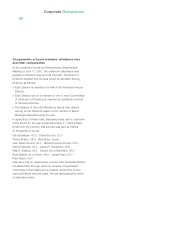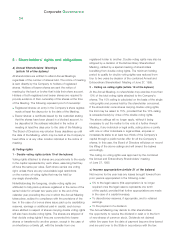APC 2002 Annual Report Download - page 37
Download and view the complete annual report
Please find page 37 of the 2002 APC annual report below. You can navigate through the pages in the report by either clicking on the pages listed below, or by using the keyword search tool below to find specific information within the annual report.
Business Review
Business review
36
1 - Economic environment
The global economy was on a downtrend for the second year
running. Consumer spending helped yield a positive rate
of growth globally (up 1.7% for global GDP in 2002),
but corporate capital spending fell again, particularly
in the developed countries.
A group of factors led companies to cut their spending
in 2002:
September 11, the ensuing geopolitical developments and
the threats of war in Iraq since May 2002 have undermined
manufacturers’ confidence and affected the outlook
for business, both of which are vital if corporate spending
is to recover.
Company tinkering with accounting rules and the collapses
of Enron (December 2001) and Worldcom (August 2002)
accentuated the fall in the stock market and repercussions
on spending.
Companies wished to restore their accounts to healthier
positions, hurt as they were by economic slowdown and
acquisitions made in previous years.
It has also emerged that companies in Europe overinvested
and overstocked in 2000. Although not on such a vast scale
as in the US, this excess spending resulted in capacity
build-up which will make current additional investment less
necessary.
Among the major Schneider Electric markets, the building
market (spending in non-residential buildings) recorded the
most marked fall in 2002, representing the sharpest decrease
in many years, particularly in the US. The market
in Europe declined slightly. American and European cycles
were synchronized for the first time.
In both regions, the worsening situation hit the industrial
building segment first of all, followed by the offices
and commercial building segment. The causes were:
- the unfavorable economic situation;
- the uncertain outlook;
- the wish on the part of companies to restore accounts
to healthier positions;
- excess capacity built up over the last few years leading
to poor use of production capacity in industry;
- high rate of buildings unoccupied.
The public building market (schools, public services and
hospitals) continued to grow.
The Industry market was also down in 2002, though less than
the previous year. This market was the first to experience the
consequences of the recession beginning in 2001 – a
decrease in capital spending in industry, the sector most
exposed to international trade, itself negatively affected by the
US recession.
As regards the infra-annual trend, the market declined
throughout 2001 and leveled off in all divisions as from the
second quarter of 2002, but without the expected upturn.
The residential building market was the only one of the
Schneider Electric markets to continue to grow on a worldwide
level in 2002.
The fall in interest rates, the rise in assets value in the
construction industry, tax incentives, the fall in stock markets
(encouraging investment in real estate) – all promoted
residential building.
2 - Highlights of the year
a) Legrand
Schneider Electric decided to sell its 98.1% stake in Legrand,
in execution of the July 26, 2002 contract of sale agreed with
the KKR-Wendel Investissement consortium.
This decision resulted, on the one hand from the position of
the European Commission, who ruled on November 29, 2002
that the corrective measures proposed by Schneider Electric
were not sufficient to approve the merger and, on the other
hand, the hostility to the project from Legrand management.
The year 2002 therefore saw the end of the merger project
with Legrand, in spite of the favorable ruling of the European
Communities Court of First Instance (October 22, 2002), which
overturned the European Commission veto.
The sale of this holding, for 3.6 billion, bolstered the financial
strength of the Company and provided margins for financial
maneuver enabling a policy of selective acquisitions in high-
growth businesses.
























